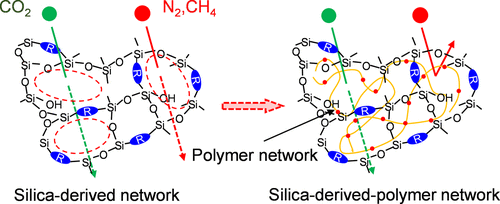当前位置:
X-MOL 学术
›
Ind. Eng. Chem. Res.
›
论文详情
Our official English website, www.x-mol.net, welcomes your feedback! (Note: you will need to create a separate account there.)
Pore Structure Controllability and CO2 Permeation Properties of Silica-Derived Membranes with a Dual-Network Structure
Industrial & Engineering Chemistry Research ( IF 4.2 ) Pub Date : 2021-06-02 , DOI: 10.1021/acs.iecr.1c00872 Keita Nakahiro 1 , Liang Yu 1, 2 , Hiroki Nagasawa 1 , Toshinori Tsuru 1 , Masakoto Kanezashi 1
Industrial & Engineering Chemistry Research ( IF 4.2 ) Pub Date : 2021-06-02 , DOI: 10.1021/acs.iecr.1c00872 Keita Nakahiro 1 , Liang Yu 1, 2 , Hiroki Nagasawa 1 , Toshinori Tsuru 1 , Masakoto Kanezashi 1
Affiliation

|
We proposed a novel method for designing CO2 permselective organosilica/polymer membranes with a dual-network structure composed of silica (first) and alkylamine-based (second) networks to control molecular sieving and CO2 adsorption properties in the membrane. Organosilica/polymer membranes were fabricated using 1,2-bis(triethoxysilyl)ethane (BTESE) or 1,2-bis(triethoxyailyl)acetylene (BTESA) as the first network, with polyethylenimine (PEI) as the second network via the sol–gel process. CO2 adsorption measurements of BTESE/PEI films were conducted via in situ Fourier transform infrared to evaluate the effects that different types of acid catalysts exert on CO2 adsorption properties. The results showed that only BTESE/PEI films prepared with a catalyst of acetic acid (HAc) display impressive chemical reactions between CO2 and amine groups, whereas the use of HCl may deactivate the amine groups. We found that the gas permeation properties of organosilica/PEI membranes were greatly dependent on the Si-precursor. Almost no selectivity could be confirmed for BTESA/PEI membranes, although pure BTESA membranes did show molecular sieving properties. However, BTESE/PEI membranes showed improved separation performance compared with that of pure BTESE membranes due to a reduction in the free volume (BTESE: H2/CH4 selectivity < 100, BTESE/PEI: H2/CH4 > 100). Moreover, the pore size of BTESE/PEI membranes could be controlled via the BTESE/PEI ratio. In conclusion, we successfully designed a dual-network structure with a controlled pore size via changes made to the Si-precursor and/or to the Si-precursor/PEI mixing ratio.
中文翻译:

双网络结构二氧化硅衍生膜的孔结构可控性和CO 2渗透性能
我们提出了一种设计 CO 2选择性渗透有机二氧化硅/聚合物膜的新方法,该膜具有由二氧化硅(第一)和烷基胺基(第二)网络组成的双网络结构,以控制膜中的分子筛分和 CO 2吸附特性。使用 1,2-双(三乙氧基甲硅烷基)乙烷(BTESE)或 1,2-双(三乙氧基甲硅烷基)乙炔(BTESA)作为第一个网络,聚乙烯亚胺(PEI)作为第二个网络,通过溶胶 -凝胶过程。BTESE/PEI 薄膜的CO 2吸附测量是通过原位傅立叶变换红外进行的,以评估不同类型的酸催化剂对 CO 2 的影响吸附特性。结果表明,只有用乙酸 (HAc) 催化剂制备的 BTESE/PEI 薄膜显示出令人印象深刻的 CO 2和胺基团之间的化学反应,而使用 HCl 可能会使胺基团失活。我们发现有机二氧化硅/PEI 膜的气体渗透特性在很大程度上取决于 Si 前体。BTESA/PEI 膜几乎没有选择性,尽管纯 BTESA 膜确实显示了分子筛分特性。然而,由于自由体积的减少,BTESE/PEI 膜与纯 BTESE 膜相比表现出更高的分离性能(BTESE:H 2 /CH 4选择性 < 100,BTESE/PEI:H 2 /CH 4> 100)。此外,BTESE/PEI 膜的孔径可以通过 BTESE/PEI 比率控制。总之,我们通过改变硅前体和/或硅前体/PEI 混合比,成功设计了具有可控孔径的双网络结构。
更新日期:2021-06-17
中文翻译:

双网络结构二氧化硅衍生膜的孔结构可控性和CO 2渗透性能
我们提出了一种设计 CO 2选择性渗透有机二氧化硅/聚合物膜的新方法,该膜具有由二氧化硅(第一)和烷基胺基(第二)网络组成的双网络结构,以控制膜中的分子筛分和 CO 2吸附特性。使用 1,2-双(三乙氧基甲硅烷基)乙烷(BTESE)或 1,2-双(三乙氧基甲硅烷基)乙炔(BTESA)作为第一个网络,聚乙烯亚胺(PEI)作为第二个网络,通过溶胶 -凝胶过程。BTESE/PEI 薄膜的CO 2吸附测量是通过原位傅立叶变换红外进行的,以评估不同类型的酸催化剂对 CO 2 的影响吸附特性。结果表明,只有用乙酸 (HAc) 催化剂制备的 BTESE/PEI 薄膜显示出令人印象深刻的 CO 2和胺基团之间的化学反应,而使用 HCl 可能会使胺基团失活。我们发现有机二氧化硅/PEI 膜的气体渗透特性在很大程度上取决于 Si 前体。BTESA/PEI 膜几乎没有选择性,尽管纯 BTESA 膜确实显示了分子筛分特性。然而,由于自由体积的减少,BTESE/PEI 膜与纯 BTESE 膜相比表现出更高的分离性能(BTESE:H 2 /CH 4选择性 < 100,BTESE/PEI:H 2 /CH 4> 100)。此外,BTESE/PEI 膜的孔径可以通过 BTESE/PEI 比率控制。总之,我们通过改变硅前体和/或硅前体/PEI 混合比,成功设计了具有可控孔径的双网络结构。



























 京公网安备 11010802027423号
京公网安备 11010802027423号